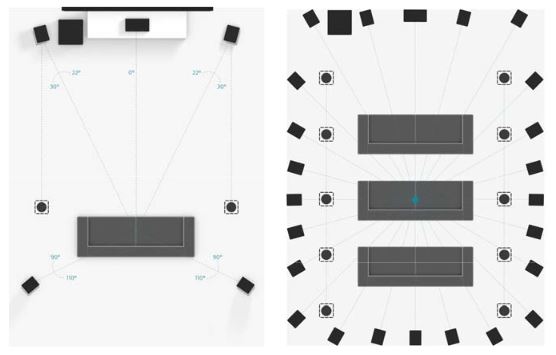

- #Dolby atmos 7.1.2 speaker placement movie
- #Dolby atmos 7.1.2 speaker placement install
- #Dolby atmos 7.1.2 speaker placement drivers
And in order to achieve this, customers now have a variety of speaker types to choose from, including in-ceiling speakers that can be installed above the listening position speakers with integrated up-firing drivers that can bounce sound off of a ceiling to simulate audio from above and add-on modules with up-firing drivers that can be placed on top of existing speakers. This is why every model in the Jensen in-ceiling speaker range features our dispersion horn technology (shown below).Dolby Atmos & DTS:X have taken the surround sound experience to the next level, allowing users to add overhead audio to their home theater setups. By doing this - even for Atmos sounds from above - your ears pick up more detail and it’s easier for them to “place” where the sound comes from.
#Dolby atmos 7.1.2 speaker placement install
This means once you can install the speaker and decide which direction to bias the sound field. Go with in-ceiling speakers with directional tilt. This gives you deeper, richer and more accurate sound. They’ll have better acoustic design, better ‘internals’ (crossover components and bracing), and tighter speaker drivers. Go with in-ceiling speakers designed for performance. They aren’t designed for audio performance and home theatre… so you end up with “tinny” and “thin” sound. There are lots of commercial in-ceiling speakers out there, the likes of which you hear in restaurants and elevators. If you can go with in-ceiling speakers, here’s what you need to know. What makes good in-ceiling speakers for Atmos? It might be better to go 7.1 and guarantee the frequencies are represented correctly. In fact, if you have to go with a set of reflective speakers - meaning you can’t possibly install in-ceiling speakers - we might even reopen this discussion of 7.1 vs. The material will boost some frequencies and reduce others.

The height of your ceiling will change the reflection angle. While these can do a decent job, they’re very much dependent on your ceiling and your room. You’ll also find “reflective speakers” which are designed to point upward and bounce Atmos audio off your ceiling. So you’re still not missing anything with 5.1.īut… they definitely won’t sound the same to your ears coming from ear level behind you, rather than directly above like they’re meant to! The 5.1 will cover all the ear-level audio needs while those two height channels recreate sounds from above, completing the “audio bubble” and making the experience more vivid.Ītmos height tracks are probably still merged with simple 5.1.ĭolby’s system for working this out probably doesn’t remove height audio. It’s another dimension of your room coming to life. Putting height channels (the “.2”) in your ceiling above you creates sound from what’s otherwise an empty void. The reason I’m pointing out these things is to draw attention to the fact that… It’s still pretty awesome adding those two extra channels and having a serious surround system playing around you. I know I’m making 7.1 sound like a waste of time and, I don’t mean to. The film’s music score will fade in from every corner of the room filling it with energy. You’ll experience panning from back left to back right. You’ll get a sense that there’s action behind you. Since 5.1 combines both surround sound tracks from 7.1, it follows that there’s no audio missing. It also might be why going from 5.1 to 7.1 only gives you a 30% (or so) boost. This is part of why your front speakers are by far the most important speakers in your system. They grab your attention more readily - which makes sense because you’d need to turn around to see what caused them - but they present slightly less detail. This tells your brain they’re coming from behind. In other words, sounds coming from behind you have certain frequencies reduced. Your ears work out where sounds come from based on the difference between your left and right ears… and the attenuation of frequencies caused by your ear shape. (That’s an arbitrary number but you get the picture.) You also get panning effects that feel a little more real.īut the improvement is more like 30%. You get a more immersive sound that’s also “bigger feeling” for any given volume level. I’m not saying it isn’t worth upgrading 5.1 to 7.1.
#Dolby atmos 7.1.2 speaker placement movie
It’s not the other way around.ħ.1 is what’s encoded in the movie content, but you can get 70-80% of the experience by combining those surround tracks on each side. The reality is… 5.1 is actually a concession on 7.1. The following explanation on the other hand, just might…ħ.1 adds two “ear level” speakers to the back I’d also say that every client who heard 7.1 vs 5.1.2 (yes everyone, at least that I can remember) agreed that Atmos was noticeably superior.īut sadly we’re not at a café. If we were sitting at a café sipping espressos I’d be telling you 5.1.2 is better because I sold home theatre for 7 years and… since the day Atmos hit stores and we set up our first demo, it was clear to us 7.1 days were numbered.


 0 kommentar(er)
0 kommentar(er)
